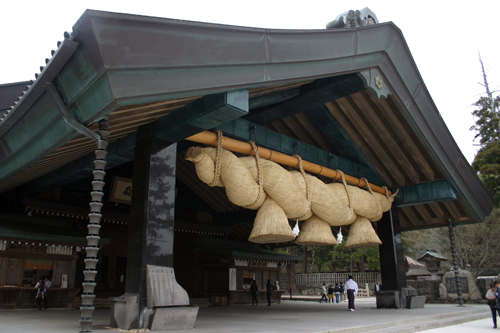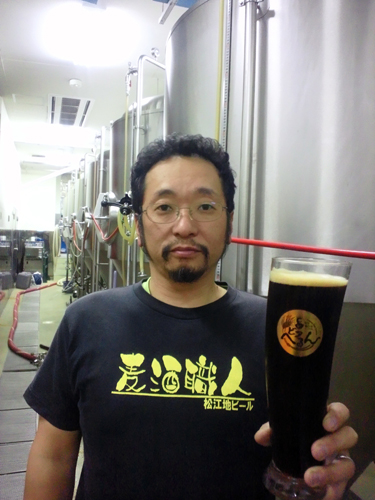
by Kumagai Jinya
Visitors from all over Japan flock to Izumo Shrine in Shimane Prefecture’s Izumo City, but in October, the gods gather as well. Along with Ise Shrine, its only peer, Izumo Shrine is one of Japan’s most important. Just about an hour away by train or car, where the prefectural government resides in Matsue, lies Shimane Beer, producers of the Beer Hearn brand. Several years ago this magazine reported on Isekadoya Beer, which makes delicious beer near Ise Shrine. These two are enough to make you think there’s a beer god in Japan, too.
Iwata of Daisen-G Beer may call him “Yanocchi,” but his real name is Yano Manabu and he’s the president of Shimane Beer. He was born and raised in Izumo and, after majoring in engineering at his university, went to work for a big sake brewery. He had dreamed of becoming head brewer, but was left to continue his work on the equipment maintenance side without an opportunity ever opening up. Then one day after about four years he read in the newspaper that a company was looking to hire people in his native Shimane to help launch a beer brewery. He decided to change jobs. That was 1996.
He had entertained hopes that with his new employment he’d get to brew soon, but it took them over two years just to decide where they wanted to break ground. During that time he was dispatched to a college in Hiroshima to study brewing; there, he practiced on some of the machinery and for a while worked on a manual for beer brewing equipment, significantly deepening his knowledge and experience.
The company finally launched in earnest on April 28th, 1999. For their brand name, they decided to use Hearn, after Lafcadio Hearn (later named Koizumi Yakumo) who is associated with the city. Born in Greece and raised in Ireland, Hearn became known as an author, educator and journalist in Japan. His ghost stories in particular are internationally known. For two years beginning in 1890, he lived in Matsue and taught English at the Shimane Prefectural Common Middle School and Normal School. The Koizumi Yakumo Memorial Museum, which houses a variety of documents related to Hearn, is but a five minute walk from Shimane Beer.
Once the plant went into production, Yano became the production manager, with three other brewers working beneath him. At the time, they produced a pilsner, weizen and pale ale. At the Matsue Horikawa Craft Beer Hall on the same campus as the brewery, they offered a taster set of their flagship beers. The opening of the hall created a lot of excitement that year among visitors, but that gradually began to wane in subsequent years. They had been relying on the hall to sell most of their beer and eventually the situation became dire.
Still bogged down in those conditions in 2002, Yano transferred of his own accord to a sake brewery that was a partner company. He was put in charge of business operations. “I was certainly sad not to be able to make beer. But by experiencing business operations as an initial occupation, I think you develop a better appreciation for just how difficult it is to sell products. I realized at that time that in order to succeed at making beer I absolutely had to understand the business side of things. Certainly making high quality beer is key, but that alone will not allow you to survive.”
Yano returned to Beer Hearn in 2004, but the company was in the red as before. Their route to market was little different and they were still relying on the hall, so he had to continue managing both brewery and business operations. Then he participated in beer festivals in Osaka and Yokohama, and their name started to get out.
Things changed when he won in 2005 at the International Beer Competition for his Enmusubi-ru Stout (a pun on “enmusubi” or love bond and “bi-ru”, or beer). Containing lactose and sporting a smooth mouth-feel, this very drinkable milk stout holds a lot of memories for Yano. The reason for the “love bond” of the name is that this brew was poured at the wedding reception for him and his wife Akiko, who is also an employee at Shimane Beer. His wife was originally a brewer elsewhere! For the reception, he served dark beer, while she brought lighter beer to serve guests. The dark beer is now his Enmusubi-ru Stout, so it’s not as if their love was “not for profit,” as the marriage vows go. And, of course, this image overlaps with that of Izumo Shrine, which you could say profits from marriage since it’s dedicated to the Shinto deity of marriage!
Let’s take a peek into why the Izumo Shrine became such a famous spot for tying the knot. According to Shinto legend, Okuninushi, the god enshrined there, gave his country over to the grandson of the sun god, Amaterasu. In return for the physical world over which he presided, he was given administration of the spiritual world. This world is understood as “the world you can’t see with your eyes,” and there, people’s “bonds” (or knots) are made. It became assumed that the sovereign of this realm governed over the creation of bonds. When you stare into the dark body of the Enmusubi-ru Bakushu Stout as you pour it into a glass, maybe you’ll catch an intimation of the world you can’t see with these eyes.
“Bonds” also carries meaning for the Chûgoku Craft Beer Association. In the Chûgoku region of Japan, there are eight member breweries that participate in study sessions on brewing and joint events (Kibidoteshita Bakushu Zôjôjo, Kaigunsan no Bakushu, Sakushutsuyama Beer, Daisen-G Beer, Chonmage Beer, Doppo Beer, Mabichikurin Bakushu and Beer Hearn). “Drinking parties” are particularly important. Companies may be different, but I think it’s important in any type of business for people of the same roles to get together and share drinks as friends. Such gatherings may enable individuals to free themselves from stagnant ideas, and its participants can help each other when needed.
Yano says, “Shimane is described as ‘the 47th most famous prefecture in Japan’ which unfortunately means it’s not famous. People often confuse Matsue with Matsuyama.” He then asserts, “which is why I feel I have to make a beer with a different kind of character.” And so like the milk stout that few others were producing, he has made beer using coffee, chocolate, honey and lemon. Additionally, he started growing hops a couple of years ago. Called “Zeus,” it once again overlaps with the image of Izumo’s god.
But Yano isn’t just making quirky beer. “An important point is ‘not only making beer that others don’t, but also making beer I want to drink.’ Making beer that I don’t want to personally drink would be negligence of my duties.”
Yano’s business development and original beer production has given steady rise to better results. “About five years ago, I realized while comparing our beers to other companies that the beers in our lineup were rather heavy. Had I not gone to festivals, I might never have realized that.”
Yano became president of Shimane Beer in 2011 and is currently in charge of business operations as well as brewing; he actually shares the role of head brewer with Tani Isao, who joined the company with him. Tani remarks, “This brewery is here in my hometown. I want to use Matsue’s natural spring water to produce beers that are suited for the town and go well with its delicious food.” When I visited them, Tani had incidentally just returned from collecting water.
In 2012, Ôishi Yasufumi joined the brewing team to help them keep up with rising production volume. Originally a salaried employee in Tokyo, he made the leap of faith and landed here to become a brewer. He brewed his first batch this April and it will go on sale in June. Many beer pubs already know of his skill for drinking and no doubt he will draw quite a few craft beer fans. Cheers for his courage in this career switch!
Yano feels he still absolutely needs to reach fans in his native Shimane. Last year, he kicked off the “San-in Craft Beer Festa in Hourai Kichijitsu An” where they rent out a traditional Japanese restaurant to enjoy food and beer together. If the marriage of beer and food is to be the next big interest of beer drinkers, then Yano is definitely ahead of the curve. This year, he plans to host the event on June 15th and August 23rd.
As Tani alluded earlier, Matsue has a lot of delicious food, including clams and sweets (my recommendation is eel). And there are many must-see sites, from Izumo Shrine to Shinji Lake, which is famous for its sunsets. Finally, a bar across the street from Matsue Station called Station Bar Spark opened two years ago, serving Beer Hearn. The beer hall mentioned earlier closes after six so visitors wanting to enjoy Beer Hearn later with some food should come here. Maybe you’ll even find Yano there taking the edge off with a few pints.

This article was published in Japan Beer Times # () and is among the limited content available online. Order your copy through our online shop or download the digital version from the iTunes store to access the full contents of this issue.



